Situational Analysis Report: Australian Market and Industry Analysis
VerifiedAdded on 2022/10/10
|10
|1523
|202
Report
AI Summary
This report presents a situational analysis focusing on the Australian market, encompassing the airline, Coca-Cola, and telecommunication industries. It employs various analytical models, including PESTLE analysis applied to the airline industry, SWOT analysis for Coca-Cola, and Five Forces analysis for the telecommunication sector. The PESTLE analysis examines political, economic, social, technological, legal, and environmental factors impacting the airline industry. The SWOT analysis evaluates Coca-Cola's strengths, weaknesses, opportunities, and threats. The Five Forces analysis assesses competitive rivalry, supplier power, buyer power, the threat of new entrants, and the threat of substitution within the telecommunication market. The report concludes by emphasizing the importance of situational analysis in providing insights for strategic decision-making and fostering competitive advantages for businesses. The analysis highlights key factors such as market share, economic conditions, consumer trends, technological advancements, legal regulations, and competitive dynamics within each sector.
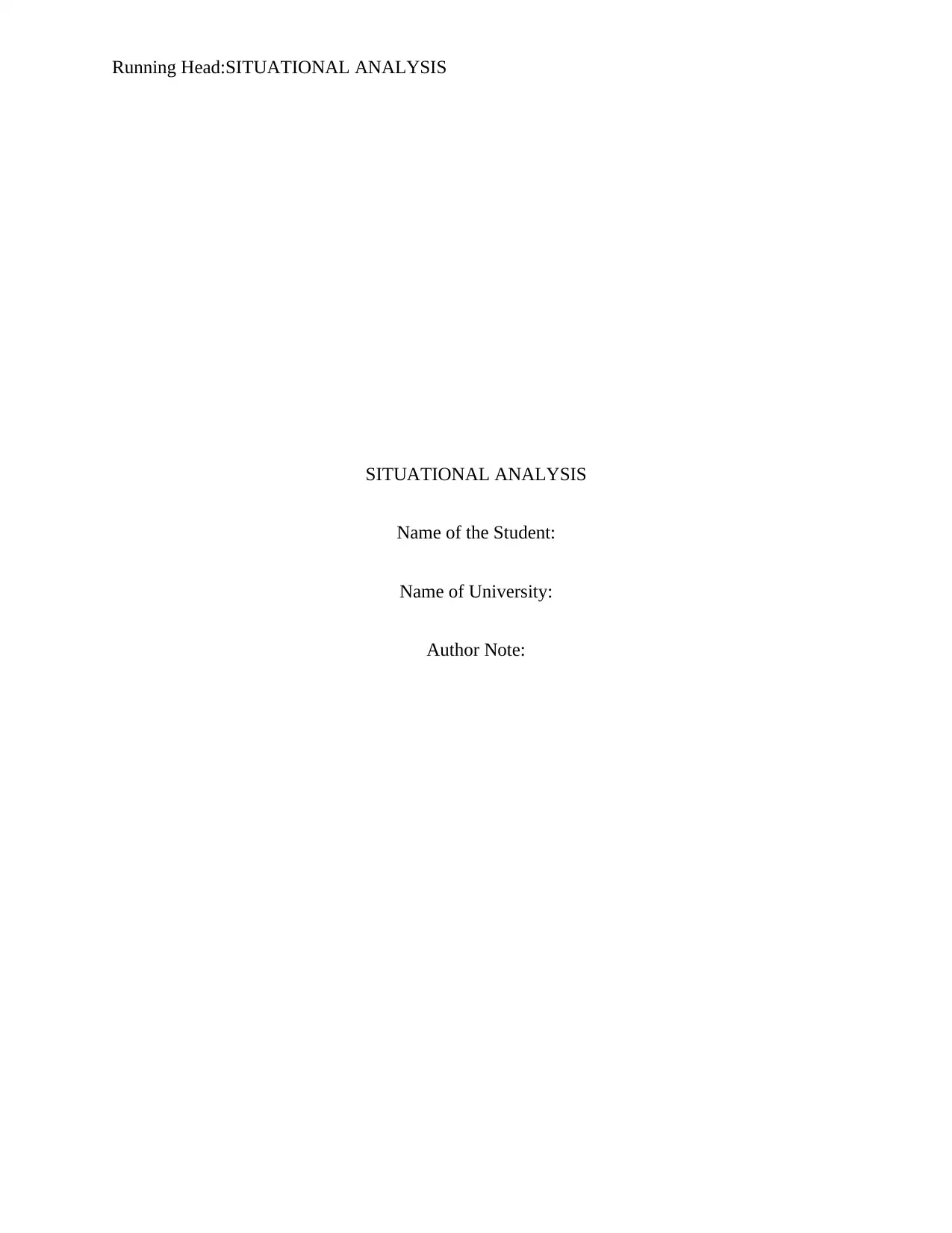
Running Head:SITUATIONAL ANALYSIS
SITUATIONAL ANALYSIS
Name of the Student:
Name of University:
Author Note:
SITUATIONAL ANALYSIS
Name of the Student:
Name of University:
Author Note:
Paraphrase This Document
Need a fresh take? Get an instant paraphrase of this document with our AI Paraphraser
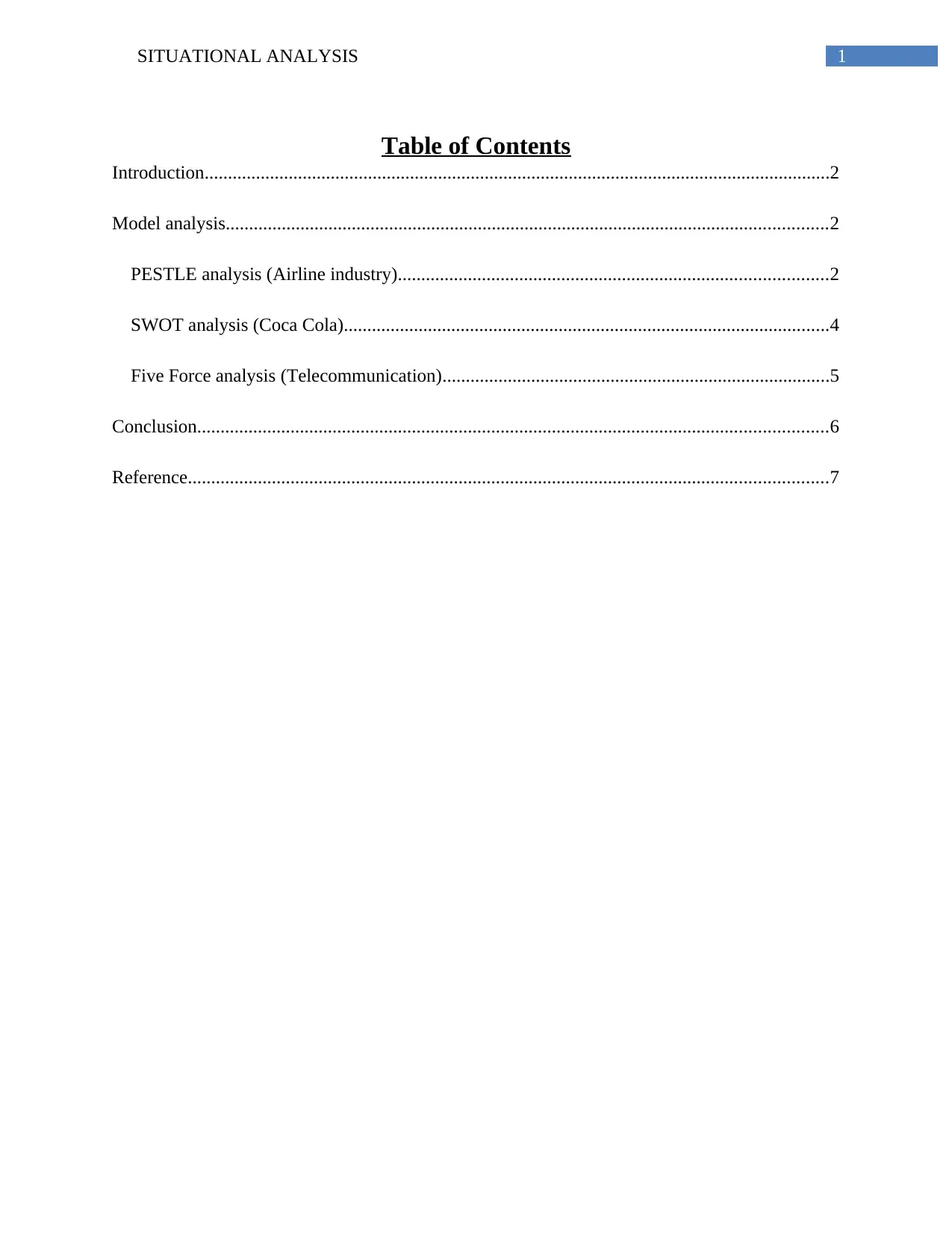
1SITUATIONAL ANALYSIS
Table of Contents
Introduction......................................................................................................................................2
Model analysis.................................................................................................................................2
PESTLE analysis (Airline industry)............................................................................................2
SWOT analysis (Coca Cola)........................................................................................................4
Five Force analysis (Telecommunication)...................................................................................5
Conclusion.......................................................................................................................................6
Reference.........................................................................................................................................7
Table of Contents
Introduction......................................................................................................................................2
Model analysis.................................................................................................................................2
PESTLE analysis (Airline industry)............................................................................................2
SWOT analysis (Coca Cola)........................................................................................................4
Five Force analysis (Telecommunication)...................................................................................5
Conclusion.......................................................................................................................................6
Reference.........................................................................................................................................7
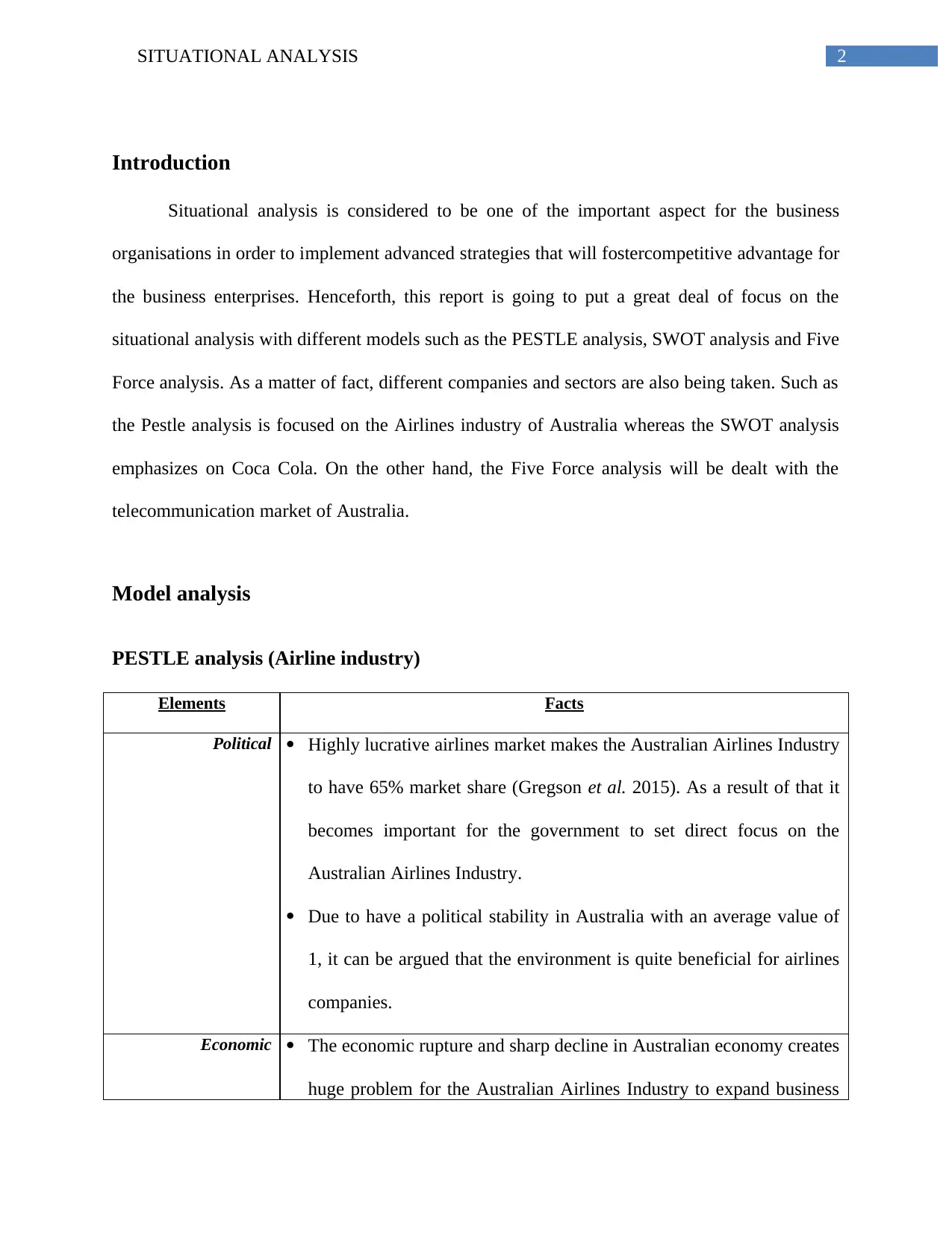
2SITUATIONAL ANALYSIS
Introduction
Situational analysis is considered to be one of the important aspect for the business
organisations in order to implement advanced strategies that will fostercompetitive advantage for
the business enterprises. Henceforth, this report is going to put a great deal of focus on the
situational analysis with different models such as the PESTLE analysis, SWOT analysis and Five
Force analysis. As a matter of fact, different companies and sectors are also being taken. Such as
the Pestle analysis is focused on the Airlines industry of Australia whereas the SWOT analysis
emphasizes on Coca Cola. On the other hand, the Five Force analysis will be dealt with the
telecommunication market of Australia.
Model analysis
PESTLE analysis (Airline industry)
Elements Facts
Political Highly lucrative airlines market makes the Australian Airlines Industry
to have 65% market share (Gregson et al. 2015). As a result of that it
becomes important for the government to set direct focus on the
Australian Airlines Industry.
Due to have a political stability in Australia with an average value of
1, it can be argued that the environment is quite beneficial for airlines
companies.
Economic The economic rupture and sharp decline in Australian economy creates
huge problem for the Australian Airlines Industry to expand business
Introduction
Situational analysis is considered to be one of the important aspect for the business
organisations in order to implement advanced strategies that will fostercompetitive advantage for
the business enterprises. Henceforth, this report is going to put a great deal of focus on the
situational analysis with different models such as the PESTLE analysis, SWOT analysis and Five
Force analysis. As a matter of fact, different companies and sectors are also being taken. Such as
the Pestle analysis is focused on the Airlines industry of Australia whereas the SWOT analysis
emphasizes on Coca Cola. On the other hand, the Five Force analysis will be dealt with the
telecommunication market of Australia.
Model analysis
PESTLE analysis (Airline industry)
Elements Facts
Political Highly lucrative airlines market makes the Australian Airlines Industry
to have 65% market share (Gregson et al. 2015). As a result of that it
becomes important for the government to set direct focus on the
Australian Airlines Industry.
Due to have a political stability in Australia with an average value of
1, it can be argued that the environment is quite beneficial for airlines
companies.
Economic The economic rupture and sharp decline in Australian economy creates
huge problem for the Australian Airlines Industry to expand business
⊘ This is a preview!⊘
Do you want full access?
Subscribe today to unlock all pages.

Trusted by 1+ million students worldwide
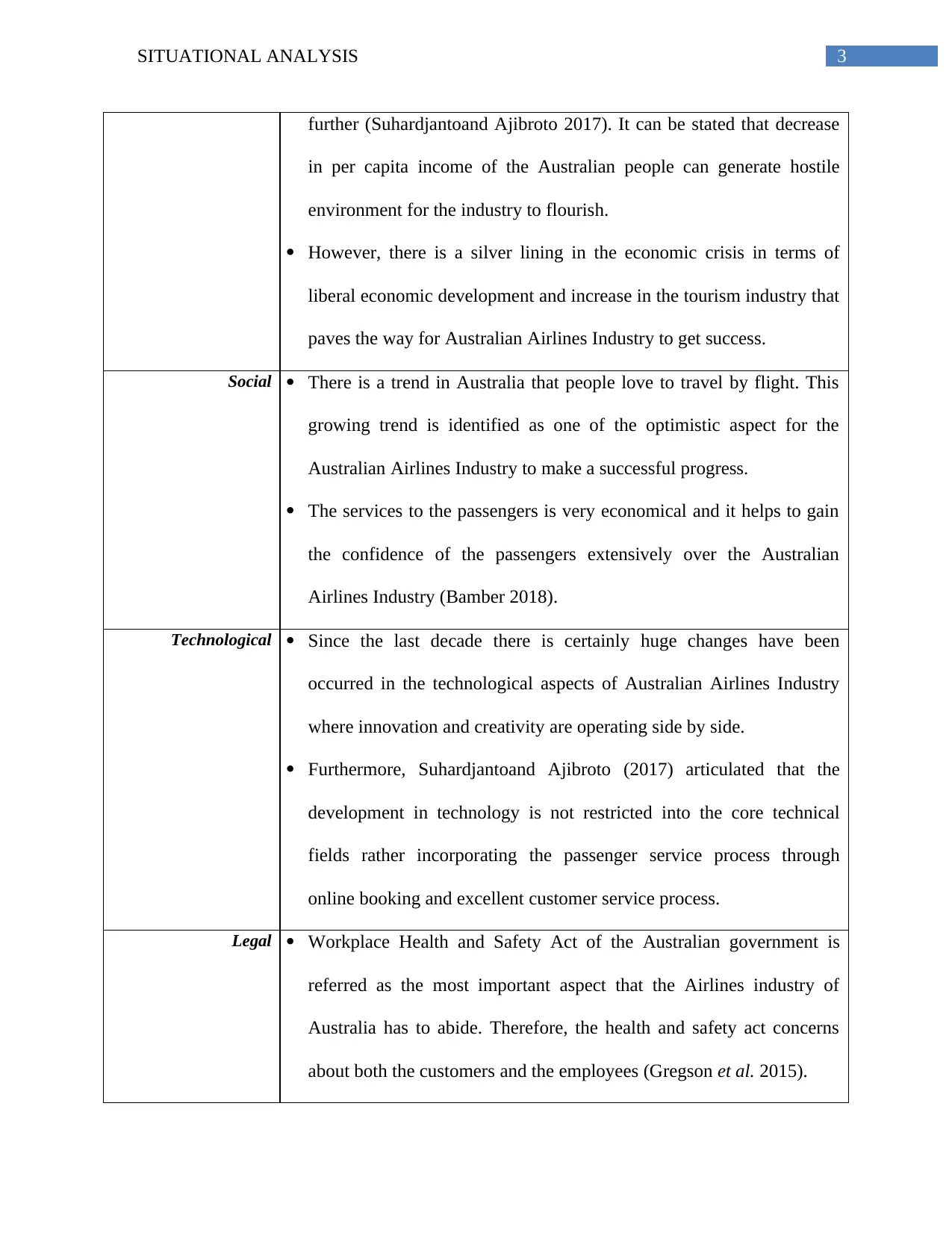
3SITUATIONAL ANALYSIS
further (Suhardjantoand Ajibroto 2017). It can be stated that decrease
in per capita income of the Australian people can generate hostile
environment for the industry to flourish.
However, there is a silver lining in the economic crisis in terms of
liberal economic development and increase in the tourism industry that
paves the way for Australian Airlines Industry to get success.
Social There is a trend in Australia that people love to travel by flight. This
growing trend is identified as one of the optimistic aspect for the
Australian Airlines Industry to make a successful progress.
The services to the passengers is very economical and it helps to gain
the confidence of the passengers extensively over the Australian
Airlines Industry (Bamber 2018).
Technological Since the last decade there is certainly huge changes have been
occurred in the technological aspects of Australian Airlines Industry
where innovation and creativity are operating side by side.
Furthermore, Suhardjantoand Ajibroto (2017) articulated that the
development in technology is not restricted into the core technical
fields rather incorporating the passenger service process through
online booking and excellent customer service process.
Legal Workplace Health and Safety Act of the Australian government is
referred as the most important aspect that the Airlines industry of
Australia has to abide. Therefore, the health and safety act concerns
about both the customers and the employees (Gregson et al. 2015).
further (Suhardjantoand Ajibroto 2017). It can be stated that decrease
in per capita income of the Australian people can generate hostile
environment for the industry to flourish.
However, there is a silver lining in the economic crisis in terms of
liberal economic development and increase in the tourism industry that
paves the way for Australian Airlines Industry to get success.
Social There is a trend in Australia that people love to travel by flight. This
growing trend is identified as one of the optimistic aspect for the
Australian Airlines Industry to make a successful progress.
The services to the passengers is very economical and it helps to gain
the confidence of the passengers extensively over the Australian
Airlines Industry (Bamber 2018).
Technological Since the last decade there is certainly huge changes have been
occurred in the technological aspects of Australian Airlines Industry
where innovation and creativity are operating side by side.
Furthermore, Suhardjantoand Ajibroto (2017) articulated that the
development in technology is not restricted into the core technical
fields rather incorporating the passenger service process through
online booking and excellent customer service process.
Legal Workplace Health and Safety Act of the Australian government is
referred as the most important aspect that the Airlines industry of
Australia has to abide. Therefore, the health and safety act concerns
about both the customers and the employees (Gregson et al. 2015).
Paraphrase This Document
Need a fresh take? Get an instant paraphrase of this document with our AI Paraphraser
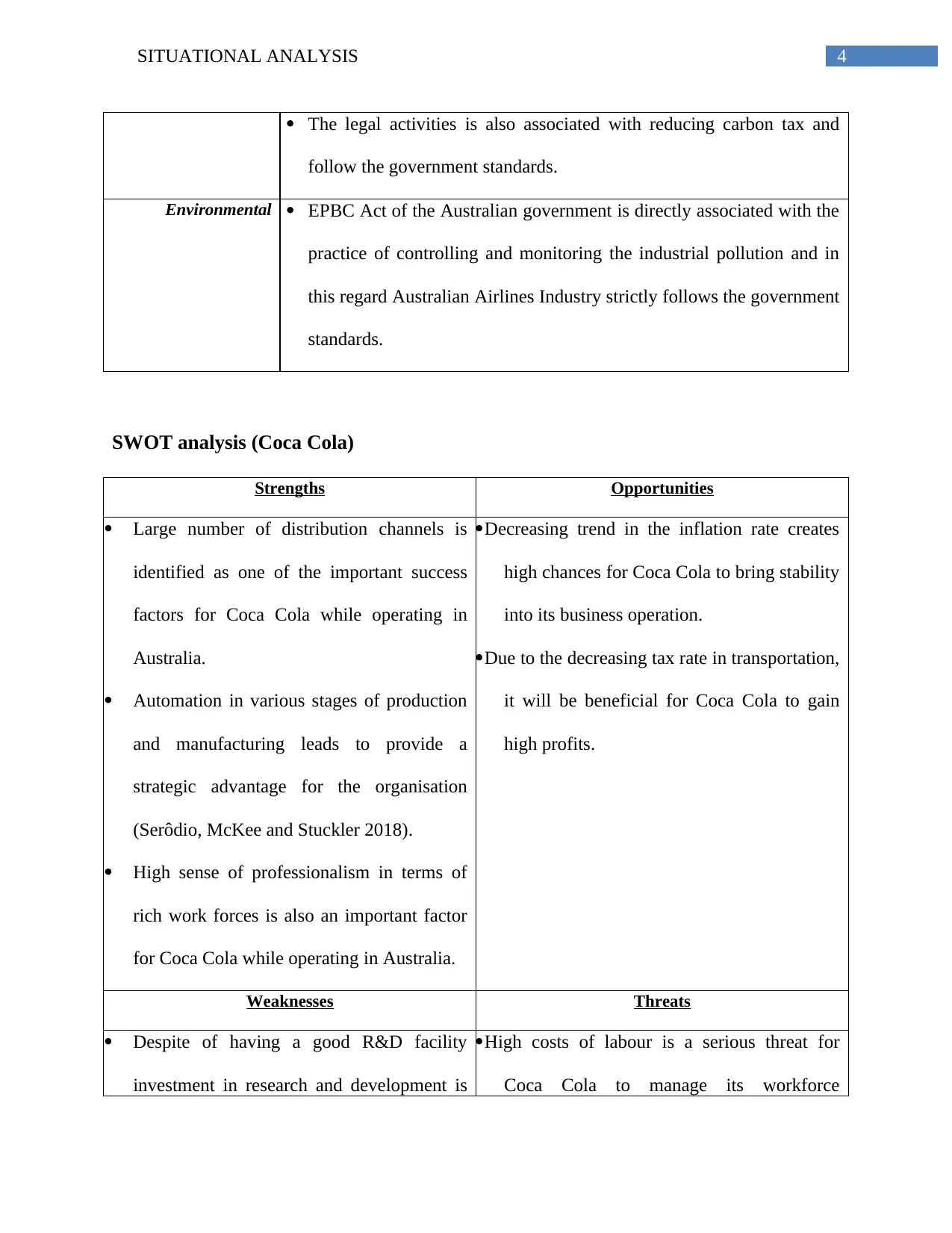
4SITUATIONAL ANALYSIS
The legal activities is also associated with reducing carbon tax and
follow the government standards.
Environmental EPBC Act of the Australian government is directly associated with the
practice of controlling and monitoring the industrial pollution and in
this regard Australian Airlines Industry strictly follows the government
standards.
SWOT analysis (Coca Cola)
Strengths Opportunities
Large number of distribution channels is
identified as one of the important success
factors for Coca Cola while operating in
Australia.
Automation in various stages of production
and manufacturing leads to provide a
strategic advantage for the organisation
(Serôdio, McKee and Stuckler 2018).
High sense of professionalism in terms of
rich work forces is also an important factor
for Coca Cola while operating in Australia.
Decreasing trend in the inflation rate creates
high chances for Coca Cola to bring stability
into its business operation.
Due to the decreasing tax rate in transportation,
it will be beneficial for Coca Cola to gain
high profits.
Weaknesses Threats
Despite of having a good R&D facility
investment in research and development is
High costs of labour is a serious threat for
Coca Cola to manage its workforce
The legal activities is also associated with reducing carbon tax and
follow the government standards.
Environmental EPBC Act of the Australian government is directly associated with the
practice of controlling and monitoring the industrial pollution and in
this regard Australian Airlines Industry strictly follows the government
standards.
SWOT analysis (Coca Cola)
Strengths Opportunities
Large number of distribution channels is
identified as one of the important success
factors for Coca Cola while operating in
Australia.
Automation in various stages of production
and manufacturing leads to provide a
strategic advantage for the organisation
(Serôdio, McKee and Stuckler 2018).
High sense of professionalism in terms of
rich work forces is also an important factor
for Coca Cola while operating in Australia.
Decreasing trend in the inflation rate creates
high chances for Coca Cola to bring stability
into its business operation.
Due to the decreasing tax rate in transportation,
it will be beneficial for Coca Cola to gain
high profits.
Weaknesses Threats
Despite of having a good R&D facility
investment in research and development is
High costs of labour is a serious threat for
Coca Cola to manage its workforce
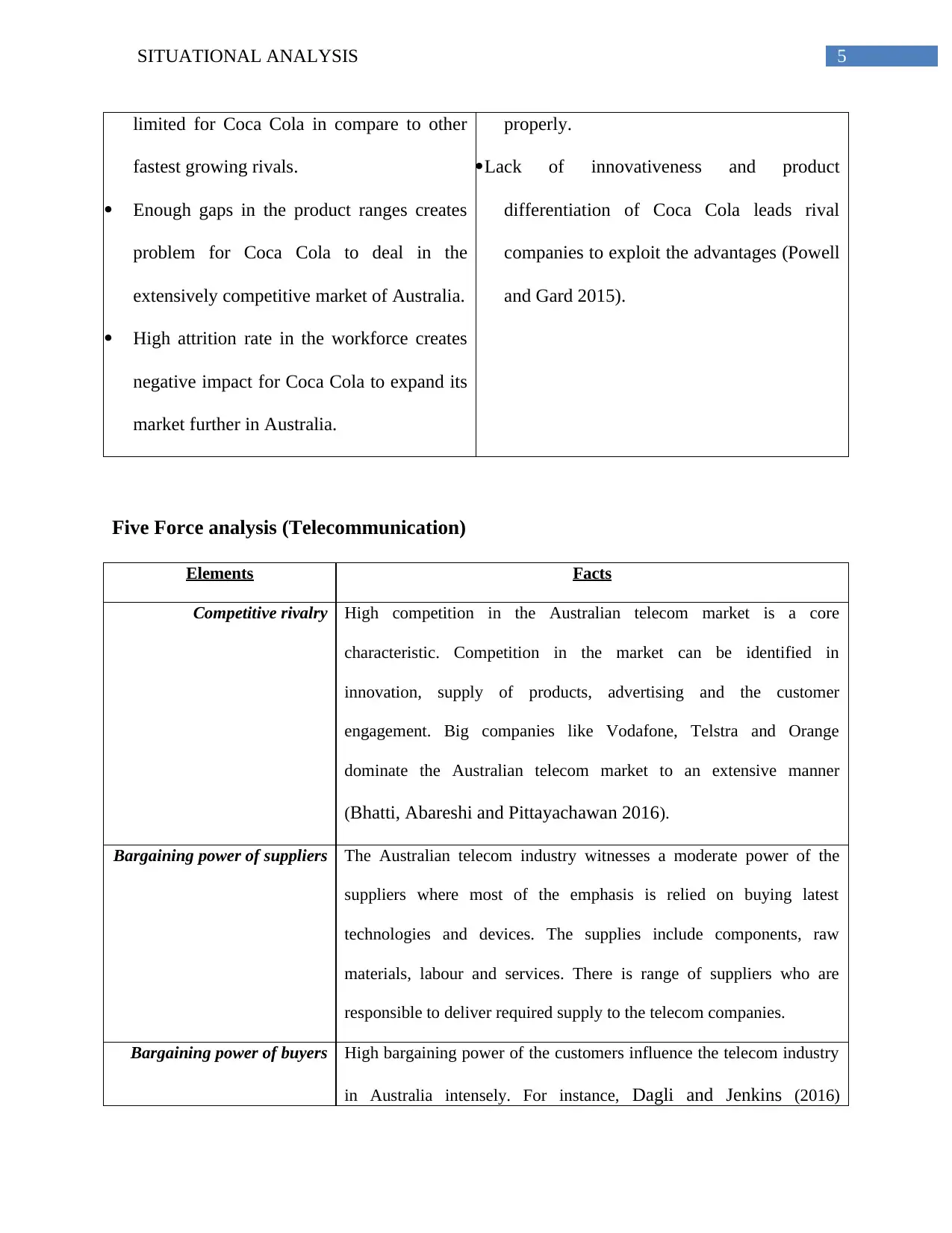
5SITUATIONAL ANALYSIS
limited for Coca Cola in compare to other
fastest growing rivals.
Enough gaps in the product ranges creates
problem for Coca Cola to deal in the
extensively competitive market of Australia.
High attrition rate in the workforce creates
negative impact for Coca Cola to expand its
market further in Australia.
properly.
Lack of innovativeness and product
differentiation of Coca Cola leads rival
companies to exploit the advantages (Powell
and Gard 2015).
Five Force analysis (Telecommunication)
Elements Facts
Competitive rivalry High competition in the Australian telecom market is a core
characteristic. Competition in the market can be identified in
innovation, supply of products, advertising and the customer
engagement. Big companies like Vodafone, Telstra and Orange
dominate the Australian telecom market to an extensive manner
(Bhatti, Abareshi and Pittayachawan 2016).
Bargaining power of suppliers The Australian telecom industry witnesses a moderate power of the
suppliers where most of the emphasis is relied on buying latest
technologies and devices. The supplies include components, raw
materials, labour and services. There is range of suppliers who are
responsible to deliver required supply to the telecom companies.
Bargaining power of buyers High bargaining power of the customers influence the telecom industry
in Australia intensely. For instance, Dagli and Jenkins (2016)
limited for Coca Cola in compare to other
fastest growing rivals.
Enough gaps in the product ranges creates
problem for Coca Cola to deal in the
extensively competitive market of Australia.
High attrition rate in the workforce creates
negative impact for Coca Cola to expand its
market further in Australia.
properly.
Lack of innovativeness and product
differentiation of Coca Cola leads rival
companies to exploit the advantages (Powell
and Gard 2015).
Five Force analysis (Telecommunication)
Elements Facts
Competitive rivalry High competition in the Australian telecom market is a core
characteristic. Competition in the market can be identified in
innovation, supply of products, advertising and the customer
engagement. Big companies like Vodafone, Telstra and Orange
dominate the Australian telecom market to an extensive manner
(Bhatti, Abareshi and Pittayachawan 2016).
Bargaining power of suppliers The Australian telecom industry witnesses a moderate power of the
suppliers where most of the emphasis is relied on buying latest
technologies and devices. The supplies include components, raw
materials, labour and services. There is range of suppliers who are
responsible to deliver required supply to the telecom companies.
Bargaining power of buyers High bargaining power of the customers influence the telecom industry
in Australia intensely. For instance, Dagli and Jenkins (2016)
⊘ This is a preview!⊘
Do you want full access?
Subscribe today to unlock all pages.

Trusted by 1+ million students worldwide
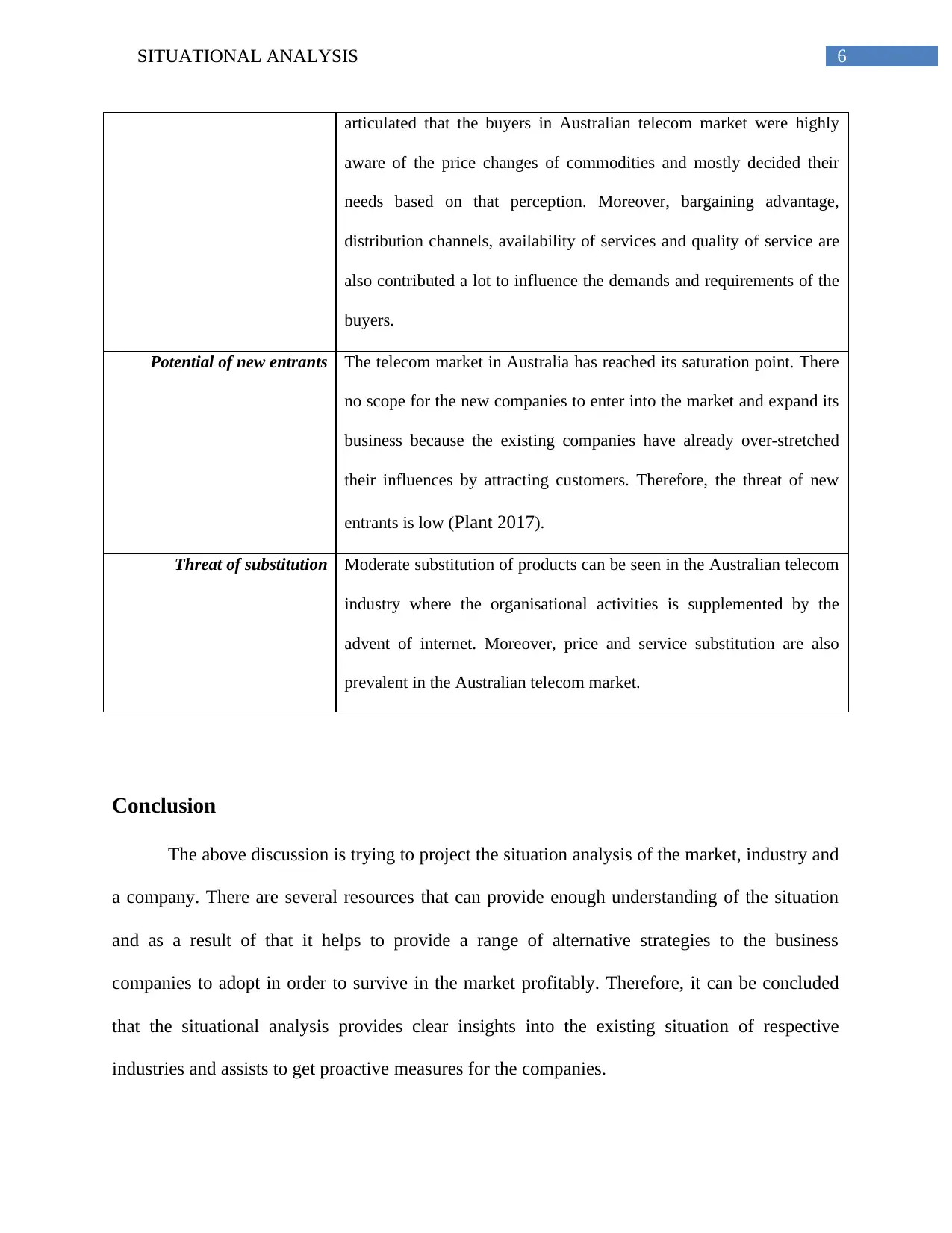
6SITUATIONAL ANALYSIS
articulated that the buyers in Australian telecom market were highly
aware of the price changes of commodities and mostly decided their
needs based on that perception. Moreover, bargaining advantage,
distribution channels, availability of services and quality of service are
also contributed a lot to influence the demands and requirements of the
buyers.
Potential of new entrants The telecom market in Australia has reached its saturation point. There
no scope for the new companies to enter into the market and expand its
business because the existing companies have already over-stretched
their influences by attracting customers. Therefore, the threat of new
entrants is low (Plant 2017).
Threat of substitution Moderate substitution of products can be seen in the Australian telecom
industry where the organisational activities is supplemented by the
advent of internet. Moreover, price and service substitution are also
prevalent in the Australian telecom market.
Conclusion
The above discussion is trying to project the situation analysis of the market, industry and
a company. There are several resources that can provide enough understanding of the situation
and as a result of that it helps to provide a range of alternative strategies to the business
companies to adopt in order to survive in the market profitably. Therefore, it can be concluded
that the situational analysis provides clear insights into the existing situation of respective
industries and assists to get proactive measures for the companies.
articulated that the buyers in Australian telecom market were highly
aware of the price changes of commodities and mostly decided their
needs based on that perception. Moreover, bargaining advantage,
distribution channels, availability of services and quality of service are
also contributed a lot to influence the demands and requirements of the
buyers.
Potential of new entrants The telecom market in Australia has reached its saturation point. There
no scope for the new companies to enter into the market and expand its
business because the existing companies have already over-stretched
their influences by attracting customers. Therefore, the threat of new
entrants is low (Plant 2017).
Threat of substitution Moderate substitution of products can be seen in the Australian telecom
industry where the organisational activities is supplemented by the
advent of internet. Moreover, price and service substitution are also
prevalent in the Australian telecom market.
Conclusion
The above discussion is trying to project the situation analysis of the market, industry and
a company. There are several resources that can provide enough understanding of the situation
and as a result of that it helps to provide a range of alternative strategies to the business
companies to adopt in order to survive in the market profitably. Therefore, it can be concluded
that the situational analysis provides clear insights into the existing situation of respective
industries and assists to get proactive measures for the companies.
Paraphrase This Document
Need a fresh take? Get an instant paraphrase of this document with our AI Paraphraser
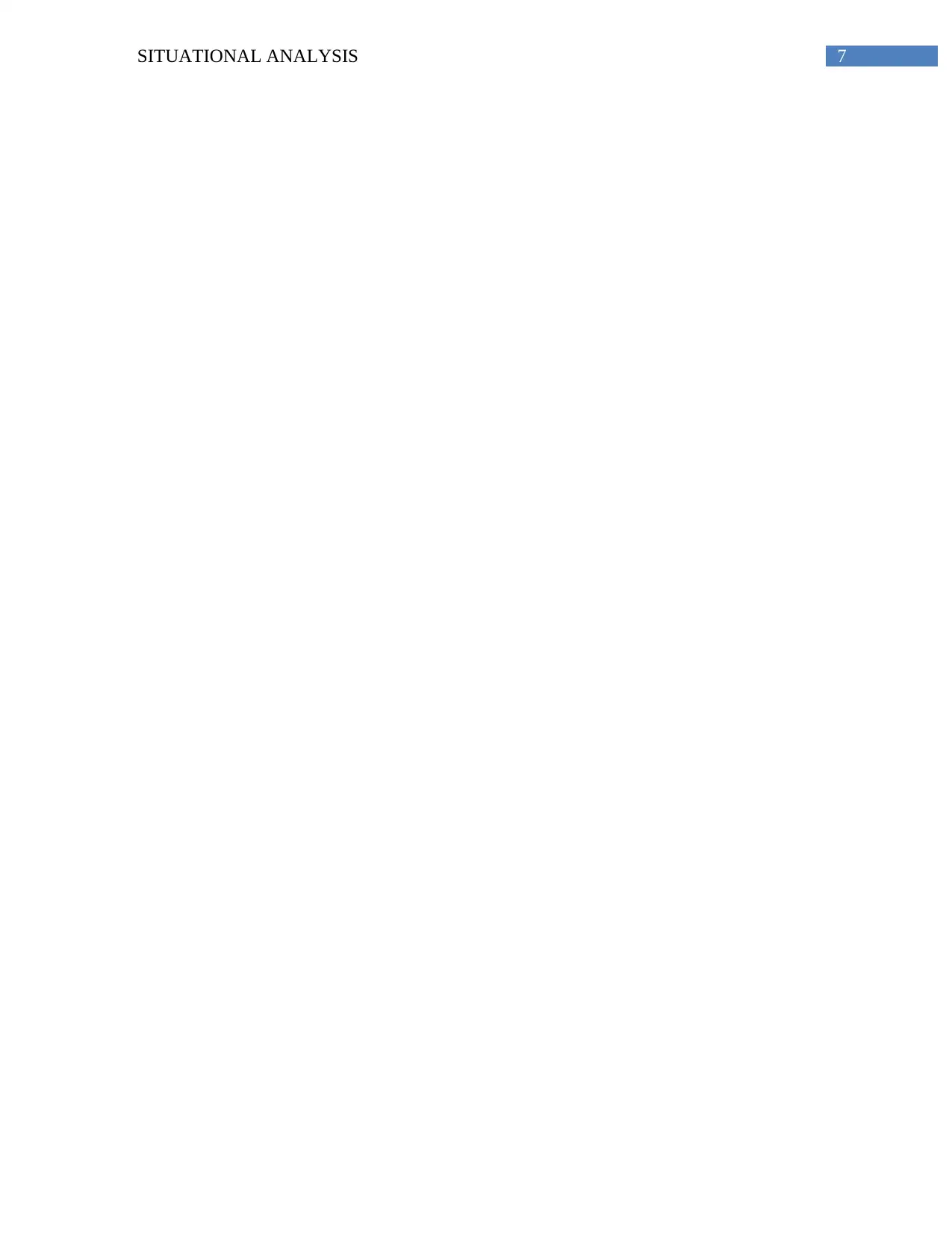
7SITUATIONAL ANALYSIS
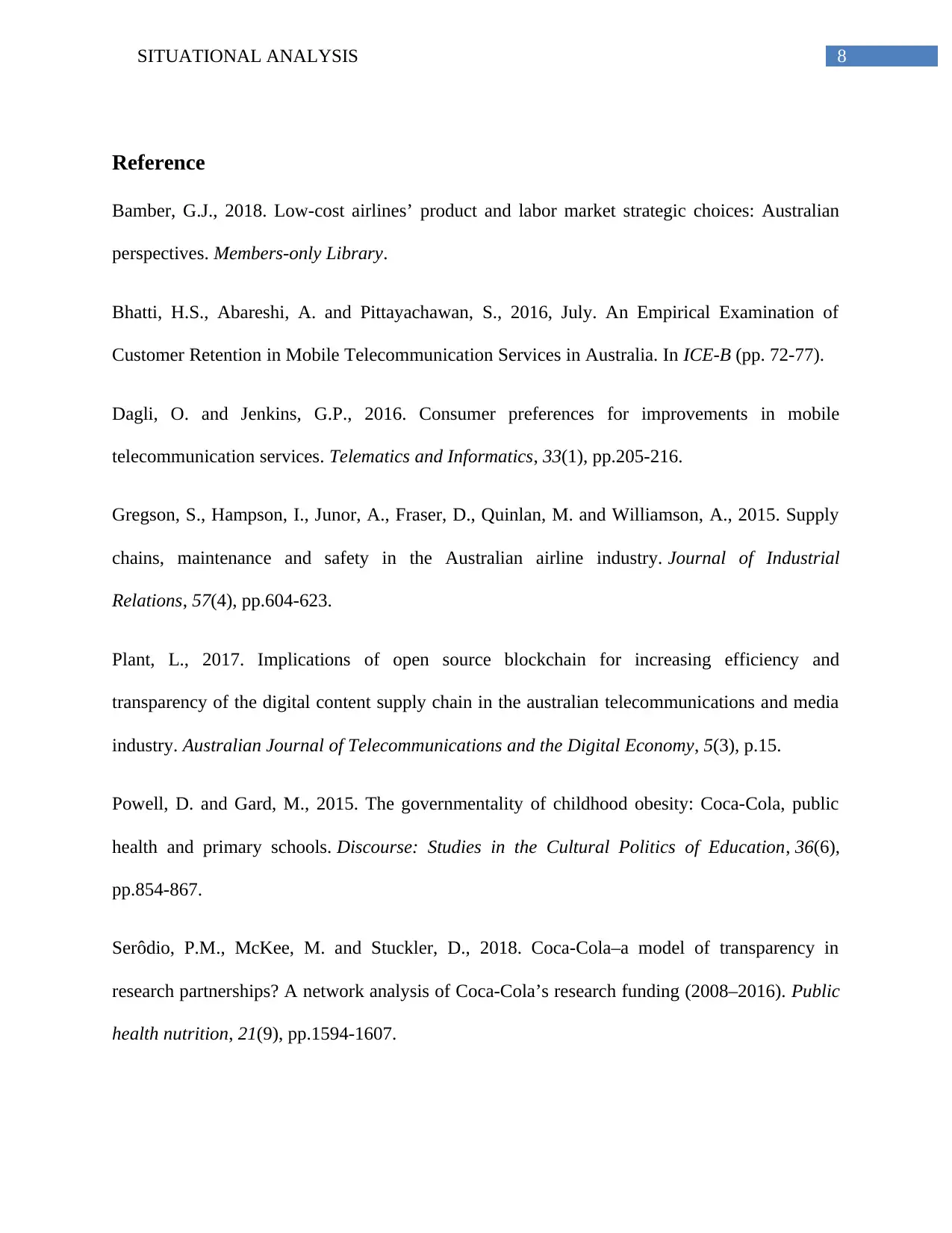
8SITUATIONAL ANALYSIS
Reference
Bamber, G.J., 2018. Low-cost airlines’ product and labor market strategic choices: Australian
perspectives. Members-only Library.
Bhatti, H.S., Abareshi, A. and Pittayachawan, S., 2016, July. An Empirical Examination of
Customer Retention in Mobile Telecommunication Services in Australia. In ICE-B (pp. 72-77).
Dagli, O. and Jenkins, G.P., 2016. Consumer preferences for improvements in mobile
telecommunication services. Telematics and Informatics, 33(1), pp.205-216.
Gregson, S., Hampson, I., Junor, A., Fraser, D., Quinlan, M. and Williamson, A., 2015. Supply
chains, maintenance and safety in the Australian airline industry. Journal of Industrial
Relations, 57(4), pp.604-623.
Plant, L., 2017. Implications of open source blockchain for increasing efficiency and
transparency of the digital content supply chain in the australian telecommunications and media
industry. Australian Journal of Telecommunications and the Digital Economy, 5(3), p.15.
Powell, D. and Gard, M., 2015. The governmentality of childhood obesity: Coca-Cola, public
health and primary schools. Discourse: Studies in the Cultural Politics of Education, 36(6),
pp.854-867.
Serôdio, P.M., McKee, M. and Stuckler, D., 2018. Coca-Cola–a model of transparency in
research partnerships? A network analysis of Coca-Cola’s research funding (2008–2016). Public
health nutrition, 21(9), pp.1594-1607.
Reference
Bamber, G.J., 2018. Low-cost airlines’ product and labor market strategic choices: Australian
perspectives. Members-only Library.
Bhatti, H.S., Abareshi, A. and Pittayachawan, S., 2016, July. An Empirical Examination of
Customer Retention in Mobile Telecommunication Services in Australia. In ICE-B (pp. 72-77).
Dagli, O. and Jenkins, G.P., 2016. Consumer preferences for improvements in mobile
telecommunication services. Telematics and Informatics, 33(1), pp.205-216.
Gregson, S., Hampson, I., Junor, A., Fraser, D., Quinlan, M. and Williamson, A., 2015. Supply
chains, maintenance and safety in the Australian airline industry. Journal of Industrial
Relations, 57(4), pp.604-623.
Plant, L., 2017. Implications of open source blockchain for increasing efficiency and
transparency of the digital content supply chain in the australian telecommunications and media
industry. Australian Journal of Telecommunications and the Digital Economy, 5(3), p.15.
Powell, D. and Gard, M., 2015. The governmentality of childhood obesity: Coca-Cola, public
health and primary schools. Discourse: Studies in the Cultural Politics of Education, 36(6),
pp.854-867.
Serôdio, P.M., McKee, M. and Stuckler, D., 2018. Coca-Cola–a model of transparency in
research partnerships? A network analysis of Coca-Cola’s research funding (2008–2016). Public
health nutrition, 21(9), pp.1594-1607.
⊘ This is a preview!⊘
Do you want full access?
Subscribe today to unlock all pages.

Trusted by 1+ million students worldwide
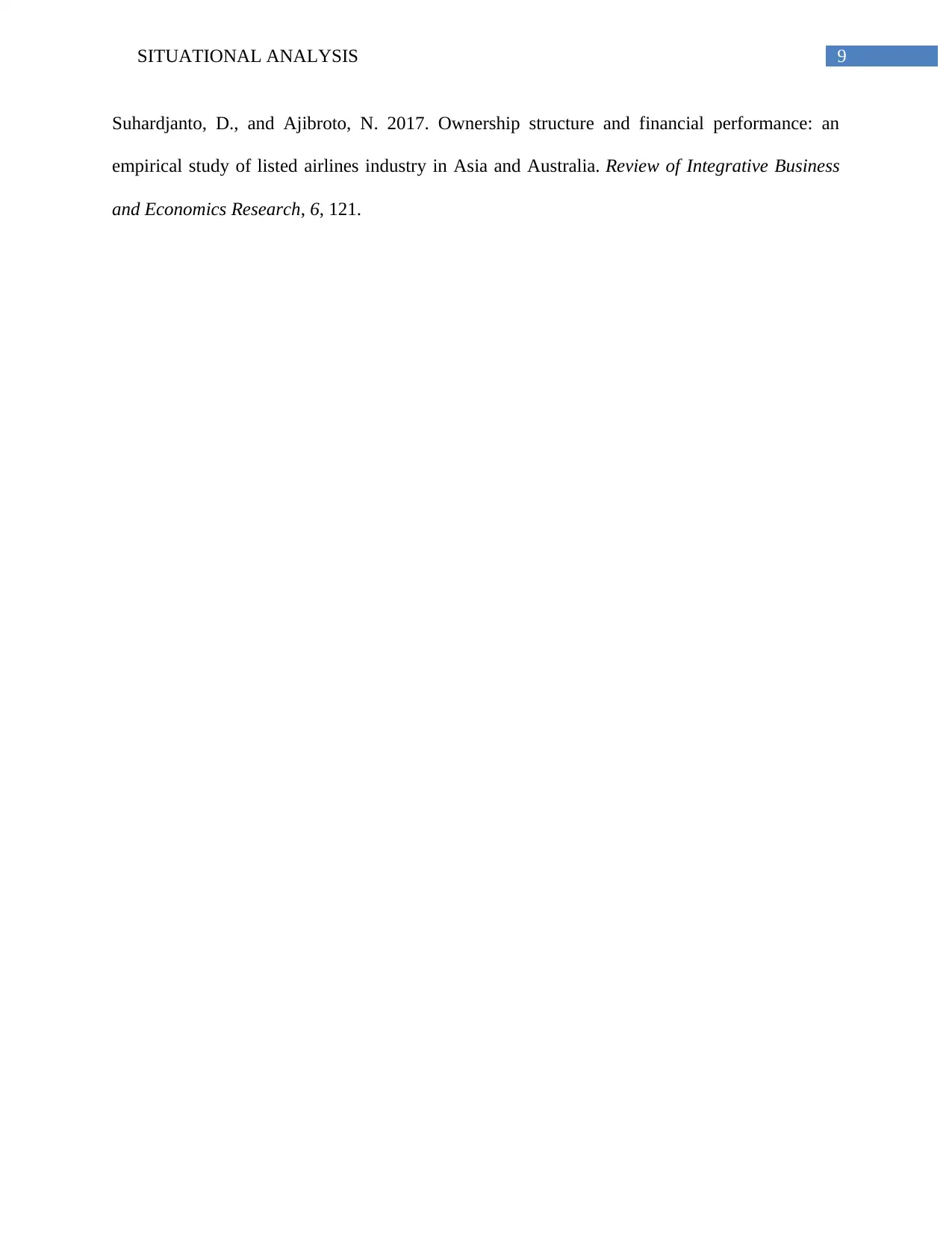
9SITUATIONAL ANALYSIS
Suhardjanto, D., and Ajibroto, N. 2017. Ownership structure and financial performance: an
empirical study of listed airlines industry in Asia and Australia. Review of Integrative Business
and Economics Research, 6, 121.
Suhardjanto, D., and Ajibroto, N. 2017. Ownership structure and financial performance: an
empirical study of listed airlines industry in Asia and Australia. Review of Integrative Business
and Economics Research, 6, 121.
1 out of 10
Related Documents
Your All-in-One AI-Powered Toolkit for Academic Success.
+13062052269
info@desklib.com
Available 24*7 on WhatsApp / Email
![[object Object]](/_next/static/media/star-bottom.7253800d.svg)
Unlock your academic potential
Copyright © 2020–2025 A2Z Services. All Rights Reserved. Developed and managed by ZUCOL.




